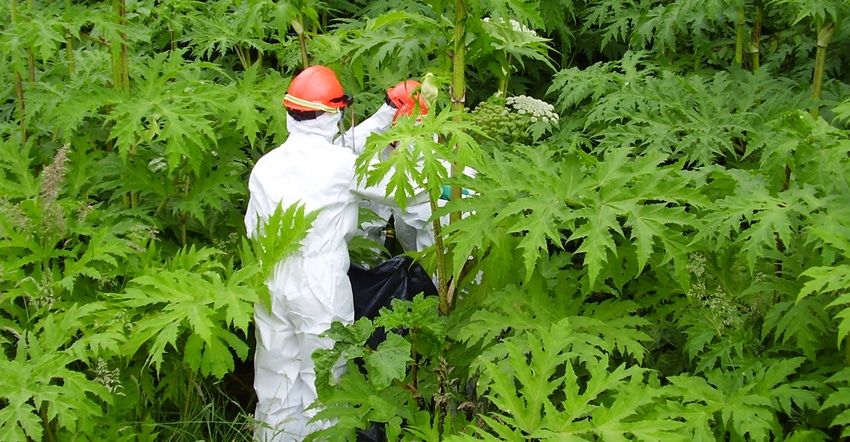July 11, 2018

By Emilie Justen
Giant hogweed, or Heracleum mantegazzianum, has recently been in national headlines after it was confirmed for the first time in Virginia.
Although listed in Minnesota as a prohibited noxious weed, giant hogweed has not been confirmed in Minnesota.
In 2011, the Minnesota Department of Agriculture and the Minnesota Noxious Weed Advisory Committee recommended to Commissioner of Agriculture Dave Frederickson that he pre-emptively list giant hogweed as a means of raising awareness, and to make sure it would be reported if found. Originally brought to North America as an ornamental plant, giant hogweed escaped cultivation and can be found in isolated pockets in many states, including parts of Wisconsin.
Giant hogweed is a stunningly tall plant with a serious public health risk. When the sap comes in contact with skin that is then exposed to sunlight, it can cause painful blisters and scarring. Additionally, the sap in contact with eyes can result in blindness.
Giant hogweed has flowers on a 10- to 15- foot stalk, with deeply cut leaves up to 5 feet across. The plant produces large clusters of tiny white flowers that reach up to two-and-a-half feet across. Stalks are 2inches in diameter and hollow, with purple mottling. Both the stems and undersides of the leaves are covered in coarse white hairs.
Giant hogweed can be mistaken for cow parsnip (Heracleum maximum), a native plant that is common throughout much of Minnesota.
Cow parsnip has similar leaves and flowers. Cow parsnip reaches 3 to10 feet tall and has 4- to 8-inch flowers. However, giant hogweed has much larger, strongly dissected leaves and huge flowers.
Watch the You Tube video below from Vancouver, Canada, to see the differences between the two species.
The impacts of giant hogweed are numerous. Not only is giant hogweed a serious public health hazard, but it also can also negatively impact soil dynamics and fisheries, and outcompete native plants. In states where it has been confirmed, it can be found growing in yards, ditches, open wooded areas and disturbed areas, and along stream bank. It thrives in sunny locations.
Giant hogweed spreads by seed that can be moved by wind, water, wildlife and humans.
Even though this plant has not yet been discovered in Minnesota, MDA regulates giant hogweed as a prohibited noxious weed on its “eradicate” list. It is also a federal noxious weed regulated by the USDA. By law, all above- and below-ground plant parts must be destroyed, and no transportation, propagation or sale of the plants is allowed.
If you suspect you have seen giant hogweed, contact the MDA’s Arrest the Pest unit at [email protected].
Justen is the noxious weed law coordinator with the Minnesota Department of Agriculture.
You May Also Like




